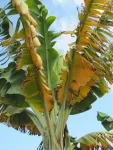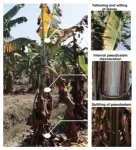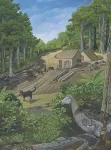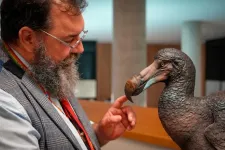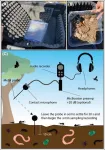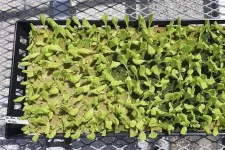The banana apocalypse is near, but UMass Amherst biologists might have found a key to their survival
Discovery of molecular mechanisms used by the banana-destroying microbe brings hope to the breakfast table
2024-08-16
(Press-News.org) August 16, 2024
The Banana Apocalypse is Near, but UMass Amherst Biologists Might Have Found a Key to Their Survival
Discovery of molecular mechanisms used by the banana-destroying microbe brings hope to the breakfast table
AMHERST, Mass. – The bananas in your supermarket and that you eat for breakfast are facing functional extinction due to the disease Fusarium wilt of banana (FWB) caused by a fungal pathogen called Fusarium oxysporum f.sp. cubense (Foc) tropical race 4 (TR4). However, thanks to recent research from an international team of scientists led by the University of Massachusetts Amherst, we now know that Foc TR4 did not evolve from the strain that wiped out commercial banana crops in the 1950s and that the virulence of this new strain seems to be caused by some accessory genes that are associated the production of nitric oxide. The research, published in Nature Microbiology, opens the door to treatments and strategies that can slow, if not control, the as-of-yet unchecked spread of Foc TR4.
“The kind of banana we eat today is not the same as the one your grandparents ate. Those old ones, the Gros Michel bananas, are functionally extinct, victims of the first Fusarium outbreak in the 1950s.” says Li-Jun Ma, professor of biochemistry and molecular biology at UMass Amherst and the paper’s senior author.
Today, the most popular type of commercially available banana is the Cavendish variety, which was bread as a disease-resistant response to the Gros Michel extinction. For about 40 years, the Cavendish banana thrived across the globe in the vast monocultured plantations that supply the majority of the world’s commercial banana crop.
But by the 1990s, the good times for the Cavendish banana had begun to come to a close. “There was another outbreak of banana wilt,” says lead author Yong Zhang, who completed his doctorate in UMass Amherst’s Organismic and Evolutionary Biology program under Ma’s direction. “It spread like wildfire from South-East Asia to Africa and Central America.”
“We have spent the last 10 years studying this new outbreak of banana wilt,” says Ma, who is an expert in Fusarium oxysporum, which is not a single species but a “species complex” with hundreds of different varieties that specialize in affecting different plant hosts. These varieties are determined by the acquisition of strain-specific accessory genes in addition to a shared core genome. “We now know that the Cavendish banana-destroying pathogen TR4 did not evolve from the race that decimated the Gros Michel bananas. TR4’s genome contains some accessory genes that are linked to the production of nitric oxide, which seems to be the key factor in TR4’s virulence.”
To arrive at this conclusion, Yong, Ma and their co-authors from China and South Africa as well as universities in the U.S., sequenced and compared 36 different Foc strains collected from all over the world, including those strains that attack Gros Michel bananas. Then, with the help of UMass Amherst’s Institute for Applied Life Sciences, the team discovered that Foc TR4, responsible for the current outbreak of banana wilt, uses some accessory genes for both production and detoxification of fungal nitric oxide to invade the host.
While the team doesn’t yet know exactly how these activities contribute to disease infestation in Cavendish banana, they were able to determine that the virulence of Foc TR4 was greatly reduced when two genes that control nitric oxide production were eliminated.
“Identifying these accessory genetic sequences opens up many strategic avenues to mitigate, or even control, the spread of Foc TR4,” says Yong.
Even so, Ma is quick to point out that the ultimate problem facing one of our favorite breakfast foods is the practice of monocropping. “When there’s no diversity in a huge commercial crop, it becomes an easy target for pathogens,” she says. “Next time you’re shopping for bananas, try some different varieties that might be available in your local specialty foods store.”
Funding for this study was provided by the U.S. National Science Foundation, the U.S. Department of Agriculture’s National Institute of Food and Agriculture, the U.S. Department of Health & Human Services, the U.S. Department of Energy the National Institutes of Health, the Guangdong Science and Technology Project, CARS and the Laboratory of Lingnan Modern Agriculture Project.
Contacts: Li-Jun Ma, lijun@umass.edu
Daegan Miller, drmiller@umass.edu
END
ELSE PRESS RELEASES FROM THIS DATE:
2024-08-16
Rethinking the Dodo
Review of 400 years of scientific literature corrects the record on icon of extinction
Researchers are setting out to challenge our misconceptions about the Dodo, one of the most well-known but poorly understood species of bird.
In a paper published today [16 August 2024] in the Zoological Journal of the Linnean Society researchers from the University of Southampton, Natural History Museum (NHM) and Oxford University Museum of Natural History have undertaken the most comprehensive review of the taxonomy of the Dodo and its closest relative, the Rodriguez ...
2024-08-16
Could arts and crafts help protect the public’s mental health? A new study in Frontiers in Public Health provides evidence that indulging our creative side could provide everyone with a significant wellbeing boost. Because arts and crafts are relatively affordable and accessible, promoting the public’s access to artistic activities could provide a major boost to public mental health.
“Crafting and other artistic activities showed a meaningful effect in predicting people’s ...
2024-08-16
Barely audible to human ears, healthy soils produce a cacophony of sounds in many forms – a bit like an underground rave concert of bubble pops and clicks.
Special recordings made by Flinders University ecologists in Australia show this chaotic mixture of soundscapes can be a measure of the diversity of tiny living animals in the soil, which create sounds as they move and interact with their environment.
With 75% of the world’s soils degraded, the future of the teeming community of living species that live underground face a dire future without restoration, says microbial ecologist Dr Jake Robinson, from the Frontiers ...
2024-08-16
COLUMBUS, Ohio (August 16, 2024) – Building positive connections with teachers and peers in the classroom can be critical to the mental health and academic success of children and adolescents. Yet, a new national poll from The Kids Mental Health Foundation, conducted by Ipsos, finds half of parents believe spending too much time on technology and social media hinder children from making meaningful connections as they head into the upcoming school year.
The poll, conducted by Ipsos on behalf of ...
2024-08-16
People who are homeless often endure constant and intrusive police interactions, leaving them feeling intimidated, harassed and stigmatised, a new study finds.
More people of all ages and backgrounds are finding themselves homeless, often due to job loss or illness, as well as a lack of affordable housing. Between 2016 and 2021 homelessness increased by 5.2% in Australia.
Professor of Law Thalia Anthony from the University of Technology Sydney (UTS) said the research aimed to give a voice to people experiencing homelessness ...
2024-08-16
A rock formation spanning Ireland and Scotland may be the world’s most complete record of “snowball Earth”, a crucial moment in planetary history when the globe was covered in ice, finds a new study led by UCL (University College London) researchers.
The study, published in the Journal of the Geological Society of London, found that the Port Askaig Formation, composed of layers of rock up to 1.1km thick, was likely laid down between 662 to 720 million years ago during the Sturtian glaciation – the first of two global freezes thought to have ...
2024-08-16
Thomas Edison went through thousands of materials before he finally found the right tungsten filament to create a working lightbulb. This type of trial-and-error research continues today and is responsible for countless inventions that improve our world. Battery systems that help power our lives in many seen (and unseen) ways are one example.
However, improving these materials and devices requires more than experimentation. Modern engineers must also form a deeper understanding of the general principles that govern material performance, from which they can design better materials to achieve challenging product requirements.
In a paper ...
2024-08-16
Females’ and males’ muscles differ in glucose and fatty acid handling – but regular physical activity quickly triggers similar beneficial metabolic changes in the muscles of both sexes, new research to be presented at this year’s Annual Meeting of the European Association for the Study of Diabetes (EASD) (Madrid, 9-13 September) has found.
Exercise has a potent effect on skeletal muscle and is the most effective strategy to prevent weight loss-related muscle loss and type 2 diabetes. ...
2024-08-15
FAYETTEVILLE, Ark. — As controlled environment agriculture and vertical farming gain a greater foothold in modern agriculture, a new $300,000 grant aims to enhance hydroponic lettuce production.
Kristen Gibson, director of the Arkansas Center for Food Safety and Arkansas Agricultural Experiment Station faculty member, is the lead researcher on the grant from the U.S. Department of Agriculture’s National Institute of Food and Agriculture. Gibson says the grant provides an opportunity to meet the needs of the hydroponics industry.
“The industry is always looking for what’s going to help them grow the best product, increase profit and ...
2024-08-15
New Haven, Conn. — In humans, the process of learning is driven by different groups of cells in the brain firing together. For instance, when the neurons associated with the process of recognizing a dog begin to fire in a coordinated manner in response to the cells that encode the features of a dog — four legs, fur, a tail, etc. — a young child will eventually be able to identify dogs going forward. But brain wiring begins before humans are born, before they have experiences or senses like sight to guide this cellular circuitry. How does that happen?
In a new ...
LAST 30 PRESS RELEASES:
[Press-News.org] The banana apocalypse is near, but UMass Amherst biologists might have found a key to their survival
Discovery of molecular mechanisms used by the banana-destroying microbe brings hope to the breakfast table
